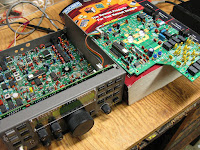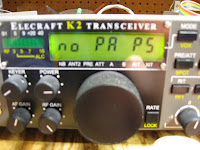In which I keep track of my progress building the Elecraft K2, KPA100, and other kits ...
Wednesday, December 29, 2010
Sunday, December 26, 2010
Lots of KPA100 Capacitors
Having finally gotten through the large number of capacitors to be stuffed on page 17, I thought it was time for a posting with some pictures.
The other instruction for the bottom-mounted capacitors concerned minimizing the amount solder used on the top of the board for these caps. This was necessary because the top-mounted relays all sit directly on top of the solder pads and have a very small, but consistent, clearance above the board. This was easy to do, and there were no problems later on with stuffing the relays.
Finally, I was unable to get RFC9 locally. I wrote to Elecraft's part line this past Monday, and had the replacement RFC in hand in Thursday morning's mail(!). Another great job by Elecraft staff and, for a change, by the USPS.
Taking a break from part-stuffing and am winding inductors, so they will be ready to stuff when I get there in the instructions.
Saturday, December 18, 2010
RFC9
I stuffed most of the resistors and was getting a start on the RFCs. I fiddled with the leads for RFC9, trying to get it to sit flush against the board, long enough to succeed in breaking off one of the leads. It was then that I had a look at the e-mail reflector, did a search on "KPA100 RFC9", and immediately got a hit. Someone was wondering about the same thing and was referred to this document. Well, I wish a reference to this document was included in the KPA100 instructions. It seems that a number of years ago Elecraft stopped using sub-miniature RFCs in favor of miniature RFCs; however, the hole spacing on the KPA100 board fit the sub-miniature parts.
One other construction note: I stuffed D1 to D8 on the bottom of the board, but the instructions did not say whether these are to be soldered on the bottom or top of the board. I looked back at the few bottom-mounted parts I had previously stuffed and, in each case, the instructions were explicit about soldering on the top. Since nothing was said here, I decided to assume that this meant "solder on the bottom", which I did.
Friday, December 17, 2010
Getting The KPA100 Underway
There aren't many resistors in this kit, but there are loads of capacitors. They are sorted out in the middle tray in the back, with the small lots in the envelopes to the right. As you can see in the right foreground, there will be quite a few inductors to be wound. All the relays, hardware (nuts, screws, washers, etc.), wire, speaker, fan, and so forth, are sorted out into ziplock bags and are back in the box, awaiting their turn.





